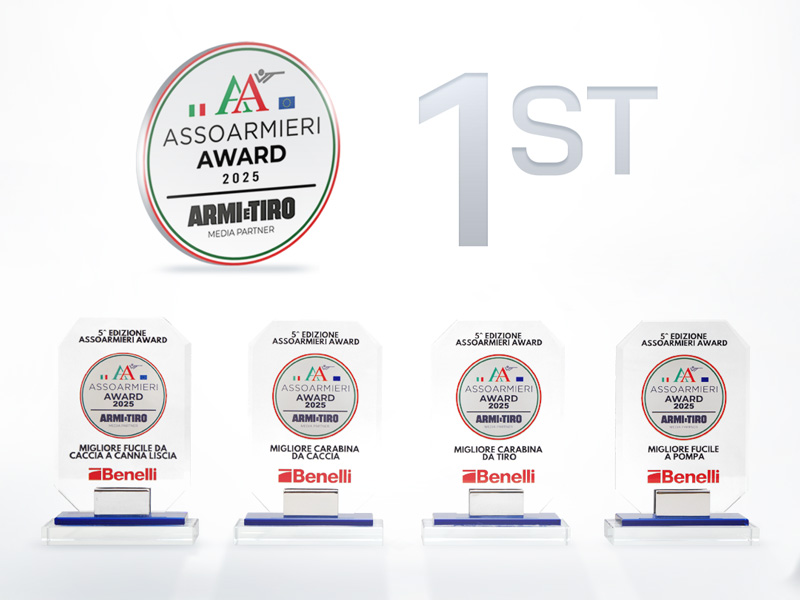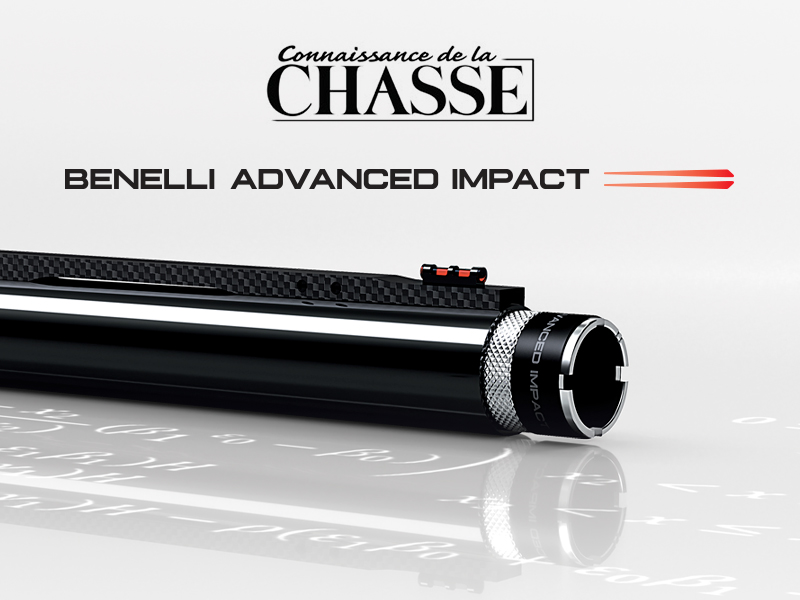29 September 2022
Hunting and the environment: from lead to the Super Magnum shotgun
From lead to Super Magnum
The shift to cartridges loaded with steel pellets has led to a momentous change in the world of semi-automatic shotguns, in which Benelli has been the main protagonist, in accordance with the innovative spirit that has always characterized it.
The star was the one and only Super Black Eagle, the first Super Magnum shotgun in history, which landed in the US as a result of the anti-lead law and immediately became a best-seller.
How did history's first Super Magnum semi-automatic shotgun come about?
Since the beginnings of portable firearms, lead has been used for projectiles because of its high specific gravity (value of 11.16), its ease of procurement, its not excessive cost, its ease of working due to its low melting point compared to other metals (327.5 °C), and its non-excessive surface hardness.
In short, lead is a soft, dense, ductile and malleable metal. In 1991, however, in response to the growing focus on environmental protection, the United States introduced a federal law to prevent lead from being used in waterfowl hunting and, since then, this metal has been progressively abandoned in hunting, not only for waterfowl hunting, but, in some cases, also for other types of hunting.
Walking in the shoes of the manufacturers of weapons and cartridges of those years, the main thought that probably crossed their minds and, who knows, also caused some sleepless nights of reflection was: “How to solve a seemingly insurmountable problem?”
The evolution of ammunition that led to the Super Magnum
After a physiological period, the responses arrived soon, each mirror of the company’s management and the philosophy of the various companies in the sector. Among the technical countermeasures that were adopted, both the bird shot ammunitions (small and big pellets) and the ball-loaded cartridges for the rifled shotgun deserve a brief examination.
The first solution was, of course, to replace lead for hunting cartridges with another metal with similar characteristics. The choice falls on bismuth (specific gravity equal to 9.78), almost interchangeable with lead except for the cost, about four times greater.
The few cartridges loaded with bismuth pellets are mainly reserved for old high-quality shotguns for which no risk is to be taken, regarding the sealing of the barrels.
Another possibility is offered by copper pellets (specific weight 9.11), which are even more expensive than bismuth, and tungsten (specific weight 19.30), which are very heavy, very expensive and very hard, therefore not suitable to replace lead.
Resin pellets mixed with tungsten powder have also been tested to achieve characteristics similar to those of lead, but still with unsustainable costs.
Hunting cartridges loaded with steel pellets for Super Magnum shotguns
Finally, the choice for the production of hunting cartridge pellets has generally fallen on steel ones.
This is because if we take stock of the advantages and disadvantages offered, it clearly appears to be by far the best option, starting with the significantly lower costs than the other solutions proposed.
Steel, an iron-carbon alloy, is rather hard, and soft iron is actually used to make pellets (although commercially they are called just steel); the high hardness of steel causes two problems.
As far as terminal ballistics is concerned, we have too much penetration of prey: wild game can be “passed” by the pellets even without them becoming deformed, to the detriment of the lethal firing.
The second problem related to the hardness of these pellets is their passage through the chokes of the shotguns' barrels: at this stage the pellets are subjected to compression due to the narrowing of the diameter of the barrel, which has never created problems with soft lead, but which may have some difficulties with the harder steel.
Some ammunition manufacturers have developed magazines in which steel pellets are mixed with plastic grit (so-called buffer) which is used precisely to cushion the compression that the pellets are subjected to.
For their part, the firearms manufacturers have also put in place a number of technical solutions. The last issue concerning the use of steel pellets is the external ballistics: steel has a specific weight significantly lower than lead (7.85 against 11.16) and so, for example, a pellet of the Italian number 5 (2.9 mm diameter) weighs 0.14 grams if it is lead and 0.09 grams if it is steel.
It goes without saying that a pellet, of the same number and with the same initial speed, will have different kinetic energy and different range depending on the material with which it is constructed.
To return to the previous example, a steel pellet weighing 0.14 grams (such as a 5-gram lead) requires a pellet of 3, i.e. of a larger diameter (3.3 mm to be exact).
A practical rule of equivalence has thus been created whereby to switch from a traditional lead pellet to a steel pellet you have to use two fewer numbers: they share the same weight.
But... there is a but: if a lead pellet and a steel pellet have the same weight, the second is larger than the first, and therefore a load of steel pellets of the same weight as a load of lead pellets takes up more space.
The problem is particularly felt in the very places where everything was born, that is to say in water hunting, for which quite robust loadings are needed in view of the considerable shooting distances.
Hence the long-standing dilemma of how to contain more steel pellets in a cartridge: do we want to increase the size of the gauge or lengthen the cartridge?
Many manufacturers saw in the first solution a possible answer to the problem, turning toward the 10 gauge.
Benelli chose a different path and, with a genius intuition, successfully overcame the swamps in which American hunters had gotten stuck.
The era of the first Super Magnum semi-automatic shotgun
1991, in fact, was the beginning of a new era: the 12 Super Magnum, characterized by the 89 mm (3.5 in) cartridge case.
In that year a shotgun was born that quickly became a true icon of waterfowl hunting, helping to spread the Benelli name overseas: the Super Black Eagle.
This was due not only to its exceptional ballistic performance.
First of all, the 89-chambered allows great versatility of ammunition, with the ability to shoot 3.5”, 3” and 2 ¾” cartridges.
Moreover, with the Super Black Eagle, Americans were able to appreciate for the first time a design worthy of the best Made in Italy, cutting-edge engineering solutions such as Urbino’s unique inertial system and manufacturing capacity, capable of producing shotguns with the highest precision manufacturing.
Benelli gained fame and esteem among American hunters. As has already been mentioned, one of the most complex issues relating to the use of steel pellets is the passage through the choking of the barrel, which is extremely delicate because of its hardness.
The steel “lily” in Super Magnum barrels
For this reason, cartridges loaded with steel pellets must be fired only in barrels that have been tested for this use, such as those produced by Benelli, which can be recognized by the stamp depicting a stylized lily affixed by the Italian Proof House after their testing.
Moreover, in order to make the firearm absolutely performing when the pellets pass through the choke, Benelli has developed and produces Crio Steel Shot mobile chokes.
These chokes are made of special alloy to be used specifically with steel pellets, which have elongated connecting chamfers, in order to avoid pinching the pellets and to ensure the highest ballistic performance combined with the resistance to use of steel ammunition, thanks to the cryogenic treatment they are subjected to.
On the other hand, with regard to ball-loaded cartridges intended for semi-automatic rifled shotguns, it can be said that the solution... came about before the problem.
In fact, in addition to the widespread use of lead-core armored bullets, so-called monolithic pellets (known in English as solid), developed mainly for big-game hunting, began to spread in the late 1970s in order to achieve better performance both in terms of penetration and expansion.
These monolithic pellets are made of copper (or an alloy of copper) and in some cases have an apical profile of plastic which is used to improve the feeding of cartridges loaded with them.
With the possible increase in future cases of lead prohibition even outside lake areas, ammunition manufacturers have not been caught unprepared and monolithic copper-pellet cartridges are now available for all the most commonly used gauges.
There are no incompatibility problems with their use in firearms and, in the case of monolithic copper pellets obtained by turning (there are also models obtained by stamping), a very high degree of accuracy is often achieved in shooting.
The costs are certainly higher than traditional lead, but accuracy and efficiency are very high, too.
In conclusion, what might have been a limitation at first, thanks to ingenuity and the willingness to seek the best solutions in every circumstance, has turned into a stimulus, responding to the growing focus of the hunting world on environmental protection and, at the same time, creating a new class of products, the Super Magnum shotguns, which have won fans from all over the world.
Benelli semi-automatic shotguns with Super Magnum chamber

14/02/2025
Benelli Wins the Assoarmieri Award 2025 in Four Categories
As every year, Benelli participated in the EOS Show, the exhibition dedicated to hunting, sport shooting, and outdoor disciplines. This even...

11/07/2024
Benelli Advanced Impact: best technology in 2023
The "Trophées Connaissance de la Chasse" awarded to Benelli Armi S.p.A. for its Benelli Advanced Impact technology. France - Benelli Armi S.p.A...

13/06/2024
The best smooth barrel shotguns of 2024 are Benelli
Benelli wins the Shooting Sports Retailer "GOLD Award" in the shotgun - smooth barrel shotguns category. As in previous years, the American mag...



